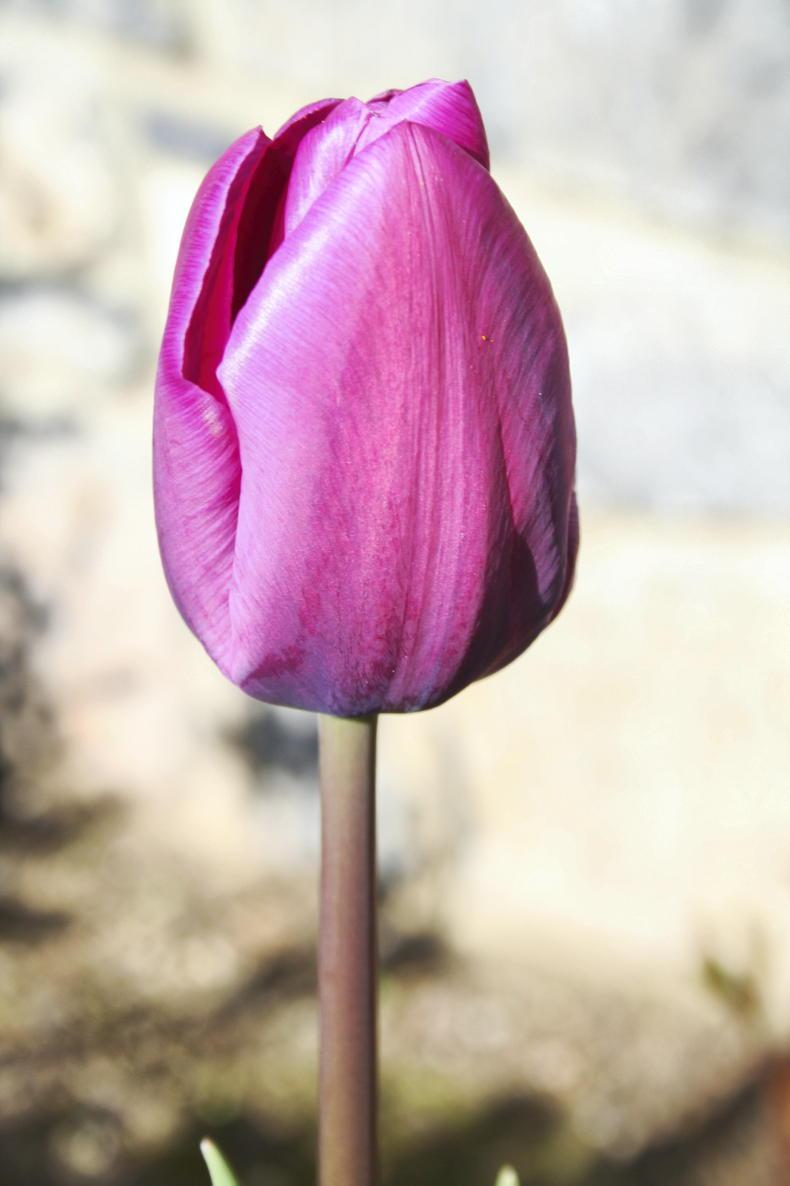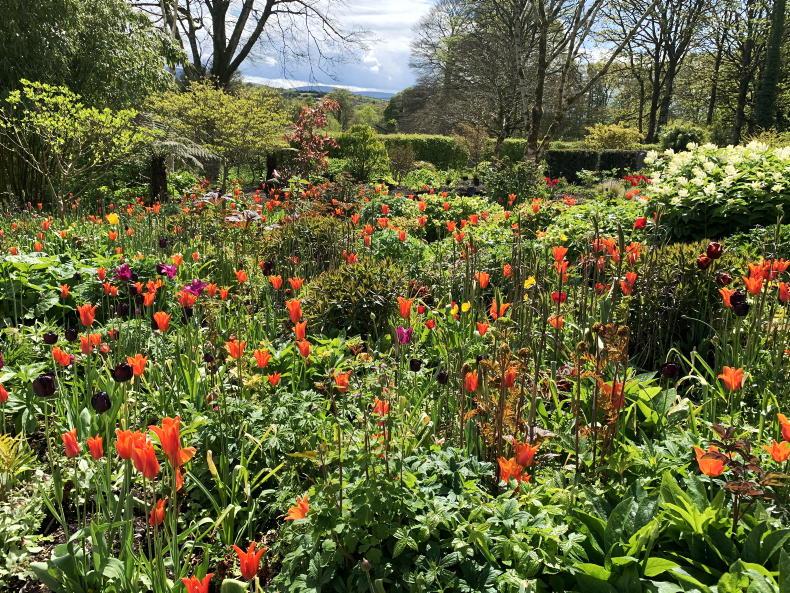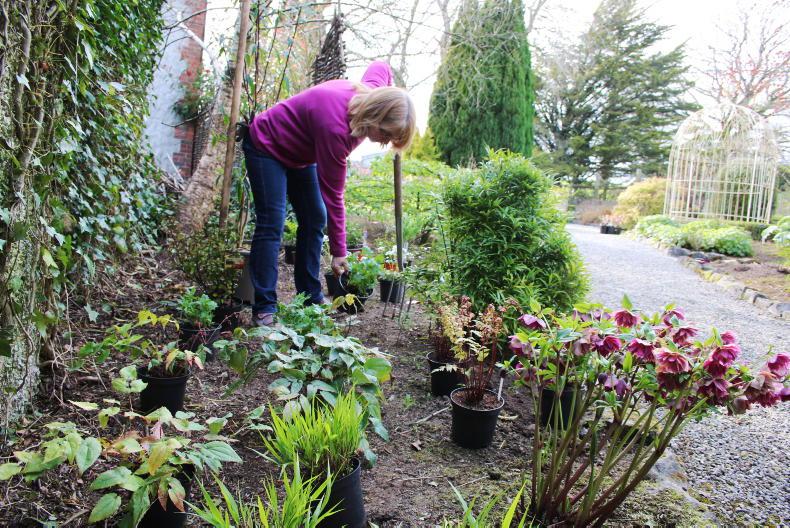Now that the big spring tidy-up is near done, with all the perennials cut back, weeds under control, beds mulched and grass cutting under way, it’s time to turn attention to planned renovations of some of our planted areas.
The first area to get a makeover is a shady, north-facing border, backed by a 2m high wall and with a nearby silver birch tree overhanging. One of the most common misconceptions in gardening is that shade is somehow less good than sun, or that it is a problem to be solved.
Not so. Shade inevitably means shelter from wind and rain, as well as the sun. It only becomes a problem when too much light is excluded or not enough rainfall gets through to the soil. Fortunately, the range of plants that thrive in shady conditions is astonishing and, by choosing shade-loving plants, we can easily transform this so-called problem area into something beautiful.
Thicket
We began by removing a thicket of mixed shrubbery that had passed its useful life, taking out the stumps and digging out as much of the residual roots as we could. A plum-coloured hellebore growing alongside the fragrant, winter-flowering shrub Sarcococca orientalis and a drift of Pulmonaria ‘Opal’ with soft blue flowers and silver-spotted leaves were all that was left in situ towards the front of the border, where they are happily thriving.
Before introducing the new plants, we liberally applied a thick layer of well-rotted farmyard manure over the soil and dug it in to enhance retention of moisture and nutrients. The key to success with a shady border is good soil amelioration and choosing the right plants. Once planted, regular watering will be required to help the plants get established.
The key to success with a shady border is good soil amelioration and choosing the right plants
Top of my list for any shady spot, and especially those with drier soils, are epimediums. In this border, I have planted Epimedium ‘Pink Champagne’, currently displaying sprays of large, icy pink flowers with darker, raspberry-red centres. These dangle on wiry stems over evergreen, arrow-shaped foliage. Between the existing hellebore and the sarcococca, a grouping of the Japanese fern Athyrium otophorum var. okanum has slotted in nicely to provide textural contrast. Although beautifully delicate in appearance, it is a reliable grower that performs well where other plants might fail to thrive.
Fascination
The plant collector in me has a long-held fascination for Solomon’s seal and any new planting in a shady position is an opportunity to indulge my fondness for these stalwarts of shade.
This time I have planted Polygonatum x hybridum ‘Betberg’. The delicate, bell-like flowers that dangle beneath the gracefully arching stems in May are typically ivory white, but the distinguishing features of this variety are the new stems and leaves that emerge a dusky, slate purple before fading to green as they mature.

Place plant support frames over tall-growing perennials, like peonies, delphinium and lupins, before they get too large. \ Mary Keenan
For later flowering and to add height towards the back of the border, we included a grouping of Kirengeshoma palmata. Its tall, ebony stems arch under the weight of waxy, lemon-yellow flowers that are shaped like a shuttlecock and the bold, maple-like leaves associate well with hardy ferns and hostas.
A drift of the very adaptable Japanese forest grass, Hakonechloa macra, completed the new planting arrangement.
This ornamental grass forms low, fountain-like hummocks of narrow, bright green leaves that take on rich, russet tones in autumn and persist into winter. It is useful as an understorey to light shrubs and as a soft edging to paths or steps.
Tulip Time

A rainbow of tulips at the Keukenhof Gardens. \ Mary Keenan
Starting with deep purple Tulipa ‘Negrita’, the sculptured, satiny goblets of tulips make a welcome appearance in our garden this month and are a pleasant reminder of a bucket list trip I made a few years back to the renowned Keukenhof Gardens near Amsterdam. These unique gardens are open for only about eight weeks from mid-March to the end of May.

Tulipa "Negrita". \ Mary Keenan
Around the last week of April was a good time to visit as every type of flower on display was blooming. The gardens are spread over 32ha, with an impressive seven million bulbs planted by hand in the autumn every year. There are over 800 different varieties of tulips and other spring-flowering bulbs to explore and views extend from the gardens to the rainbow-like, flower-growing fields beyond.

June Blake's garden at tulip time. \ Mary Keenan
Closer to home, in her garden near Blessington in Co Wicklow, June Blake is inspiringly creative with her more informal and experimental use of tulips, in a wide range of shades and hues, intermingled with early flowering perennials. June’s garden opens to visitors from early April with a month-long celebration of tulips. Visit www.juneblake.ie.
This Month’s To-Do List
Use an edging iron or sharp spade to define a sharp, neat edge between flower borders and lawn areas. Prune early flowering shrubs like chaenomeles and forsythia that have finished flowering. Control slugs and snails by applying a biological treatment of nematodes to the soil around vulnerable plants like hostas. These microscopic worms seek out slugs and are active when ground temperatures reach 7°C. Repeat applications every six weeks.Timely Reminder
Place plant support frames over tall-growing perennials, like peonies, delphinium and lupins, before they get too large so the stems will grow through the supports and hide them completely.
Out and About
Clare Garden Festival
Sunday, 24 April 11am-5pm Ennis Showgrounds – gardening talks, specialist nurseries and plant fair, crafts, artisan foods and more.
Garden talks
Free garden talks at Kilkenny Castle on 26 April, 3 May and 10 May. Further information: www.kilkennycastle.ie
Upcoming Plant Fairs:
Sunday, 1 May: RHSI Plant Fair. Venue: Russborough House, Co Wicklow Sunday, 8 May: Rare and Special Plant Fair. Venue: Fota House and Gardens, Co Cork. Read more
A warm welcome to Mary’s garden
Mary's Garden: planting trees and plants for free
Now that the big spring tidy-up is near done, with all the perennials cut back, weeds under control, beds mulched and grass cutting under way, it’s time to turn attention to planned renovations of some of our planted areas.
The first area to get a makeover is a shady, north-facing border, backed by a 2m high wall and with a nearby silver birch tree overhanging. One of the most common misconceptions in gardening is that shade is somehow less good than sun, or that it is a problem to be solved.
Not so. Shade inevitably means shelter from wind and rain, as well as the sun. It only becomes a problem when too much light is excluded or not enough rainfall gets through to the soil. Fortunately, the range of plants that thrive in shady conditions is astonishing and, by choosing shade-loving plants, we can easily transform this so-called problem area into something beautiful.
Thicket
We began by removing a thicket of mixed shrubbery that had passed its useful life, taking out the stumps and digging out as much of the residual roots as we could. A plum-coloured hellebore growing alongside the fragrant, winter-flowering shrub Sarcococca orientalis and a drift of Pulmonaria ‘Opal’ with soft blue flowers and silver-spotted leaves were all that was left in situ towards the front of the border, where they are happily thriving.
Before introducing the new plants, we liberally applied a thick layer of well-rotted farmyard manure over the soil and dug it in to enhance retention of moisture and nutrients. The key to success with a shady border is good soil amelioration and choosing the right plants. Once planted, regular watering will be required to help the plants get established.
The key to success with a shady border is good soil amelioration and choosing the right plants
Top of my list for any shady spot, and especially those with drier soils, are epimediums. In this border, I have planted Epimedium ‘Pink Champagne’, currently displaying sprays of large, icy pink flowers with darker, raspberry-red centres. These dangle on wiry stems over evergreen, arrow-shaped foliage. Between the existing hellebore and the sarcococca, a grouping of the Japanese fern Athyrium otophorum var. okanum has slotted in nicely to provide textural contrast. Although beautifully delicate in appearance, it is a reliable grower that performs well where other plants might fail to thrive.
Fascination
The plant collector in me has a long-held fascination for Solomon’s seal and any new planting in a shady position is an opportunity to indulge my fondness for these stalwarts of shade.
This time I have planted Polygonatum x hybridum ‘Betberg’. The delicate, bell-like flowers that dangle beneath the gracefully arching stems in May are typically ivory white, but the distinguishing features of this variety are the new stems and leaves that emerge a dusky, slate purple before fading to green as they mature.

Place plant support frames over tall-growing perennials, like peonies, delphinium and lupins, before they get too large. \ Mary Keenan
For later flowering and to add height towards the back of the border, we included a grouping of Kirengeshoma palmata. Its tall, ebony stems arch under the weight of waxy, lemon-yellow flowers that are shaped like a shuttlecock and the bold, maple-like leaves associate well with hardy ferns and hostas.
A drift of the very adaptable Japanese forest grass, Hakonechloa macra, completed the new planting arrangement.
This ornamental grass forms low, fountain-like hummocks of narrow, bright green leaves that take on rich, russet tones in autumn and persist into winter. It is useful as an understorey to light shrubs and as a soft edging to paths or steps.
Tulip Time

A rainbow of tulips at the Keukenhof Gardens. \ Mary Keenan
Starting with deep purple Tulipa ‘Negrita’, the sculptured, satiny goblets of tulips make a welcome appearance in our garden this month and are a pleasant reminder of a bucket list trip I made a few years back to the renowned Keukenhof Gardens near Amsterdam. These unique gardens are open for only about eight weeks from mid-March to the end of May.

Tulipa "Negrita". \ Mary Keenan
Around the last week of April was a good time to visit as every type of flower on display was blooming. The gardens are spread over 32ha, with an impressive seven million bulbs planted by hand in the autumn every year. There are over 800 different varieties of tulips and other spring-flowering bulbs to explore and views extend from the gardens to the rainbow-like, flower-growing fields beyond.

June Blake's garden at tulip time. \ Mary Keenan
Closer to home, in her garden near Blessington in Co Wicklow, June Blake is inspiringly creative with her more informal and experimental use of tulips, in a wide range of shades and hues, intermingled with early flowering perennials. June’s garden opens to visitors from early April with a month-long celebration of tulips. Visit www.juneblake.ie.
This Month’s To-Do List
Use an edging iron or sharp spade to define a sharp, neat edge between flower borders and lawn areas. Prune early flowering shrubs like chaenomeles and forsythia that have finished flowering. Control slugs and snails by applying a biological treatment of nematodes to the soil around vulnerable plants like hostas. These microscopic worms seek out slugs and are active when ground temperatures reach 7°C. Repeat applications every six weeks.Timely Reminder
Place plant support frames over tall-growing perennials, like peonies, delphinium and lupins, before they get too large so the stems will grow through the supports and hide them completely.
Out and About
Clare Garden Festival
Sunday, 24 April 11am-5pm Ennis Showgrounds – gardening talks, specialist nurseries and plant fair, crafts, artisan foods and more.
Garden talks
Free garden talks at Kilkenny Castle on 26 April, 3 May and 10 May. Further information: www.kilkennycastle.ie
Upcoming Plant Fairs:
Sunday, 1 May: RHSI Plant Fair. Venue: Russborough House, Co Wicklow Sunday, 8 May: Rare and Special Plant Fair. Venue: Fota House and Gardens, Co Cork. Read more
A warm welcome to Mary’s garden
Mary's Garden: planting trees and plants for free










 This is a subscriber-only article
This is a subscriber-only article










SHARING OPTIONS: